Digging into intersectionality
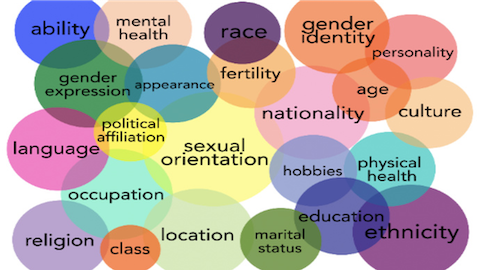
Intersectionality is a concept that’s getting a lot of attention these days. So, what is “intersectionality” and why does it matter to LGBTQ+ equity and inclusion?
Intersectionality—a brief history
Intersectionality might seem like a new concept, but it’s actually been around for a pretty long time. The legal scholar Dr. Kimberlé Crenshaw coined the term in 1989 in response to a series of court cases, including the 1976 case, DeGraffenreid vs. General Motors (“Demarginalizing the Intersection of Race and Sex”).
This case concerned seniority-based layoffs carried out by General Motors during a recession that hit the U.S. in the early 1970s. Basing layoffs on seniority—essentially, last hired, first fired—might seem like the fairest way to make tough decisions about who gets to keep vs. lose a job. But General Motors, like many companies, had a long history of discrimination and had just started to hire Black women in the 1960s. So, when seniority-based layoffs were instigated in the 1970s, nearly all Black women at GM lost their jobs (U.S. District Court for the Eastern District of Missouri, 1976).
Five Black women filed a class action Title VII lawsuit charging that the seniority policy was discriminatory. But the court disagreed, noting that General Motors had long hired Black men and White women and therefore could not have been practicing discrimination based on either race or gender. The court rejected the plaintiffs’ argument that Black women faced a unique combination of racial and gender-based discrimination that was distinct from the experiences of either Black men or White women (U.S. District Court for the Eastern District of Missouri, 1976).
As Dr. Crenshaw pointed out, the court’s single lens focus meant that it literally could not recognize the discrimination experienced by Black women. It would take an intersectional approach—one that could consider an individuals’ position at the intersection of racism and gender-based discrimination—to address more nuanced circumstances. Over time, Dr. Crenshaw’s analysis has been extended to encompass the ways that numerous aspects of our identities, including race, gender, social class, sexual identity and disability, overlap and combine in ways that shape individual experiences, including experiences of privilege and/or oppression.
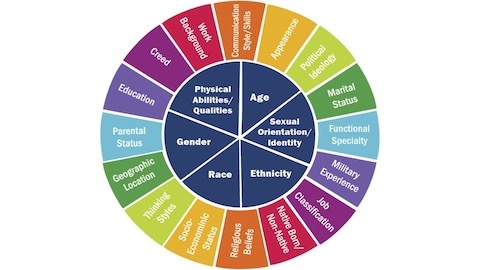
Is everyone intersectional?
You could say that everyone is intersectional to the extent that we are all complex individuals with multi-faceted identities—none of us fit neatly into single little boxes. That’s a concept that’s conveyed via the identity wheel pictured above. Any one of us can find different elements that come together to make up who we are as unique individuals. But intersectionality was conceived primarily to analyze and address discrimination as experienced by individuals whose identities place them at the intersection of two or more axes of oppression—such as race and gender, or gender and sexual identity, or social class and disability. So, in that sense, some people are more intersectional than others.
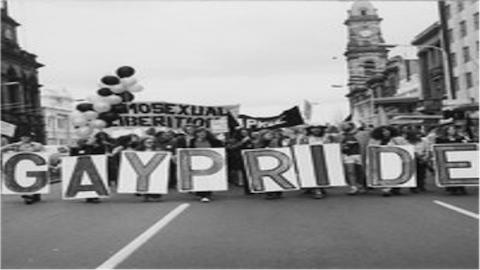
Roots in the LGBTQ+ community
Dr. Crenshaw’s work and our own understanding of intersectionality owe a lot to pioneering efforts within the LGBTQ+ community. Although Dr. Crenshaw coined the term intersectionality, her work rested on prior frameworks developed by Black feminists in the 1970s, many of whom identified as lesbians. These women founded an organization called the Combahee River Collective to focus on the concerns of Black LGBTQ+ women which were not being addressed by either the mainstream women’s movement or the civil rights movement. The Combahee River Collective’s efforts to understand multiple systems of advantage and disadvantage—including sexual identity--laid the foundation for Crenshaw’s legal analysis in the 1980s and helped pave the way for a more holistic approach in addressing discrimination (The Combahee River Collective Statement, 1977).
Intersectionality and the LGBTQ+ community today
Fast-forward several decades, and intersectionality helps us to see both commonality and diversity within the LGBTQ+ community. As gender and sexual minorities, LGBTQ+ people have a lot of common ground. They are a community—in that respect. They share a common history of both discrimination and the struggle to achieve equality. But LGBTQ+ people are also multi-faceted individuals, and they have distinct experiences, including degrees of advantage and/or disadvantage. For instance, overall poverty rates among the LGBTQ+ community are higher than in the non-LGBTQ+ population. But when we look more closely, important distinctions emerge. One group, cisgender gay white men, have a lower poverty rate, on average, than their straight counterparts—that is, cisgender straight white men. That suggests that the advantages this group has in being cisgender, white and male outweigh the disadvantage of being a sexual minority when it comes to earning power. For other groups—LGBTQ+ persons of color and LGBTQ+ women for instance--discrimination works along multiple lines to put them at an economic disadvantage vis-à-vis their straight counterparts (Badgett et al., 2013).
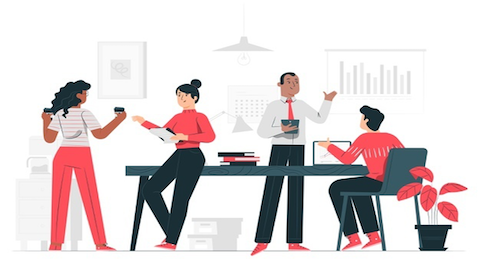
LGBTQ+ equity and inclusion—an intersectional approach
Intersectionality helps us see that If we want to achieve more equal outcomes for LGBTQ+ people, our policies need to take into account different facets of identity, and how they interact and compound one another. For instance, LGBTQ+ youth of color are disproportionately represented in populations of homeless youth and in populations of young people caught up in the criminal justice system. If we want to address youth homelessness and lower the population of young people in the criminal justice system, we must address discrimination along lines of both race and LGBTQ+. And we need to consider the specific challenges facing young people whose identities place them at the intersection of these two axes of oppression. If we just address one form of discrimination but leave out the other or fail to consider the specific challenges facing LGBTQ+ youth of color, then many young people will fall through the cracks—just like the Black women at General Motors did back in the 1970s.
By the same token, organizations can best be served by taking a holistic approach to policies and procedures to combat discrimination. If we take a single-lens approach to equity and inclusion efforts for LGBTQ+ individuals, we risk leaving out whole swaths of people. Only an intersectional approach provides a nuanced understanding of who is or is not benefitting from existing diversity, equity and inclusion strategies, allowing organizations to make adjustments accordingly. Are women of color benefitting equally to white women, for instance, or are the needs of transgender individuals being addressed alongside employees who are gay or bisexual? Are women or nonbinary individuals with disabilities finding opportunities within the organization?
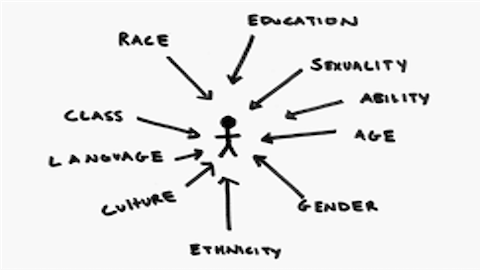
An intersectional lens
Intersectionality helps us all to see one another as we really are so that we may act accordingly. Every one of us is a complex individual, and we experience different facets of our identity simultaneously, not discreetly. None of us can divide ourselves up into neat little boxes—much as the legal system, or some social frameworks—might want us to. As contemporary scholars Linda E. Carty and Chandra Talpade Mohanty put it, “All of us live complex lives . . . [W]e are [all] actually living at the intersection of overlapping systems of privilege and oppression" (Coleman, 2019). That’s why intersectionality is at the forefront of diversity, equity and inclusion strategies—including for the LGBTQ+ community.
About the author--Kathleen Clark is Chief Learning Officer of Identiversity Inc. She lives with her family in Charlotte, NC and writes widely on topics relating to diversity, equity and inclusion.
References:
Badgett, M. V. L., Durso, L., & Schneebaum, A. (2013, June). New patterns of poverty in the lesbian, gay, and bisexual community. Williams Institute, UCLA School of Law. https://williamsinstitute.law.ucla.edu/publications/lgb-patterns-of-poverty/
Coleman, Arica L. (2019, March 29). What's Intersectionality? Let These Scholars Explain the Theory and It's History. Time. https://time.com/5560575/intersectionality-theory/
Crenshaw, Kimberlé. (1989). Demarginalizing the Intersection of Race and Sex: A Black Feminist Critique of Antidiscrimination Doctrine, Feminist Theory and Antiracist Politics. University of Chicago Legal Forum, Vol. 1989, Issue 1, Article 8. http://chicagounbound.uchicago.edu/uclf/vol1989/iss1/8
The Combahee River Collective. (1977). The Combahee River Collective Statement. https://www.blackpast.org/african-american-history/combahee-river-collective-statement-1977/
U.S. District Court for the Eastern District of Missouri. DeGraffenreid v. General Motors. 413 F. Supp. 142, E.D. Mo., 1976. https://law.justia.com/cases/federal/district-courts/FSupp/413/142/1660699/
